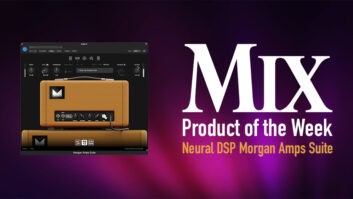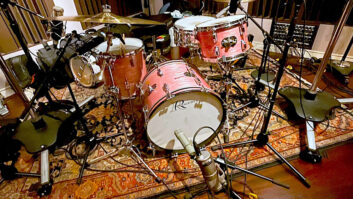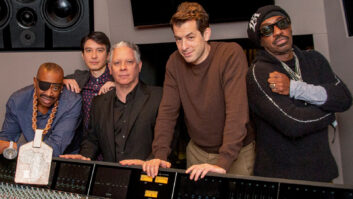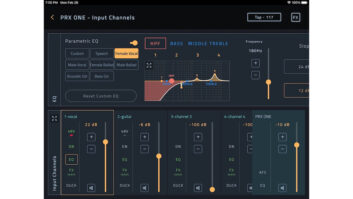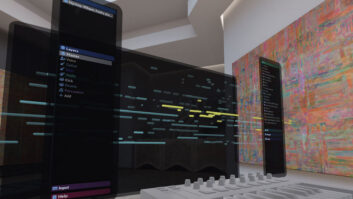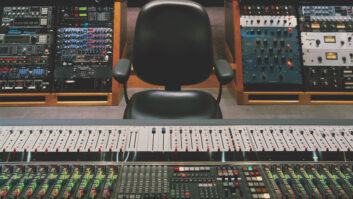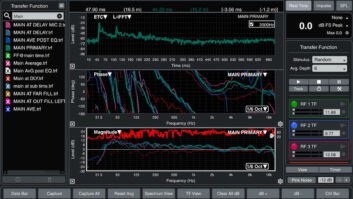Morgan Page with Dangerous D-Box
With multiple Billboard Chart hits, Morgan Page tunes up his studio with Dangerous D-Box
Edmeston, NY – January 12, 2010 – Morgan Page is a Billboard dance chart-topping remixer and producer who works in his own computer-based studio full of software plug-ins, hi-end audio hardware and most recently the award-winning Dangerous Music D-Box. Page’s remix of Jody Watley’s “I Want Your Love,” was his third #1 Billboard hit following his remixes of “Angelicus” by Delerium and Nelly Furtado’s “Maneater,” and with La Roux “Bulletproof” he achieved 6 Number One Billboard hits. In 2009, “The Longest Road,” (Deadmau5 Remix) was nominated for a Grammy in the Best Remix category, and he launched his latest single “Fight For You” which has steadily climbed the Billboard Club Play charts to #4. In February 2010, Morgan Page will release “Believe,” an album that makes good on his International Dance Music Awards nomination as Best Breakthrough Artist, and typifies his journey from bootleg remixer to award-winning producer and DJ.
The new Dangerous Music hardware Page recently added to his system, the Dangerous D-Box, is designed for the compact studio and the modern workflow of computer musicians. The 1U rack-mount box combines 8-channels of the world-renowned Dangerous Music analog summing technology and an integrated programmable monitor control section with analog and digital inputs, on-board 24 bit/96KHz D-to-A converter, talkback, dual headphone amps, speaker switcher and more. Just the thing Page needed to take his own studio to the next level.
While recording and mixing in his studio recently, Page found a piece of equipment lacking, “I was unhappy with the monitor control situation I was using with my Digidesign 002 audio interface. I kept hearing a good buzz in the press and on the web about the Dangerous D-Box. It has a combination of features that I wanted, and I bought the D-Box initially to have a really clean and reliable way to monitor that would sound great, and wouldn’t futz around when I turned the volume down. With my old setup the speakers would cut out and I’d hear static because it was a cheap monitor controller. So I started out just using the monitoring parts of the D-Box but more recently I’ve gotten a lot more into the summing.”
Page uses Pro Tools software and has a slew of soft-synths and plug-ins, but the center of his studio now is the Dangerous D-Box, “I use both of the headphone outs while I’m tracking, one for me and one for the vocalist. I don’t use a vocal booth, I always have the vocalist behind my shoulder. I can get really quiet recordings with everyone in the room just using their headphones. I like to work quickly, so when we both have headphones on, the built-in talkback system keeps things flowing.”
“When I don’t have a singer in the studio I pump the second headphone amplifier output to a cheap Sony clock-radio player to check what a mix sounds like, to hear a sober version of the track. Just to hear it in a relatively mono soundstage. You can definitely hear when the bass is distorting; it’s just a more common denominator listening environment. I think it’s important that the D-Box has such a good signal path because you know what you are going to get later down the line. I have my Mackie 824s plugged in to the D-Box Main Speaker outputs and then occasionally I reference on the Sony clock-radio. I really want to get a second pair of speakers, I plan to get a pair of Mix Cubes or AuraTones to check the mixes on.”
All the key pieces of the latest incarnation of his studio are carefully connected, Page says, “I’m using a Digidesign 002 and version 8 of Pro Tools. I have a D-sub Mogami snake from my 8-channel Prism Orpheus converter. I use the ADAT output of the Digidesign 002 to connect to the Orpheus converter. The 8 Orpheus D/A’s convert the mix stems to analog, and these signals are summed to stereo in the D-Box. Then it goes back to a pair of Orpheus A/D converters to record the mix. I use the D-Box’s built-in D-to-A to monitor the final mix at the end of the chain – it’s connected to the S/PDIF out of the Digidesign 002. It makes a difference to go through nicer converters because sonic quality can get lost along the way.”
Describing how he breaks out tracks from Pro Tools to the 8 channels of Analog Summing in the D-Box, Page says, “I have a template in Pro Tools so I don’t have to think about the plumbing and re-routing everything. Outputs 1 and 2 are always drums, 3 and 4 are always vocals, 5 and 6 are always bass heavy stems, and 7 and 8 are any keyboards, pads and effects. If it’s an instrumental track, 3 and 4 will just be another set of keyboards or something. I’d like to get more analog summing channels in the future. I think it’s exciting now with summing to apply it to soft-synths to get that warmth and that width in the mix. It’s a new world to explore.”
Sometimes Page just experiments with the analog summing to affect the sound of a track, “A lot of the experiments I’ve done are taking Spectrasonics Stylus loops, sending them out to some dirty compressor, summing that, and sending it back through good converters. You just get different textures that way,” he says.
“What I like about the D-Box is that the transients sound really good. Everything sounds punchy and clear,” adds Page. “In terms of the sound of the summing, I like that it’s neutral, and how the summing world makes my plug-ins sound better. I like that fuller sound – there’s more width to it. One of the biggest benefits of the summing section is that I don’t have to compress mixes as much. I bring the summed stereo mix back into Pro Tools on an auxiliary channel and put the mastering plug-in Ozone 4 on it, but I don’t have to slam it as crazy as I used to. It’s sounding louder and fuller, but with less extreme threshold settings. This sort of ‘triple-threat’ of the D-Box, Orpheus, and Ozone has been awesome. I also use the Vintage Warmer plug-in, which is unbelievable, I use it for a little bit of coloring. With the summing I spend less time with my tracks ‘pulling teeth’ trying to get the sound right than with mixing in the box,” concludes Page.
Because the D-Box is a super-compact single rack, and his other key recording gear is small and rack-mounted, Page talks about traveling with his system, “Eventually I want to take the D-Box on the road, for producing other artists, or just tracking session players. I love how you don’t need so much gear to record anymore. I can bring the D-Box and the Orpheus and 002 in a rack, and track a session anywhere with my laptop. You have an incredibly powerful system, and you have your summing.”
The kind of companies he works with make a difference too; Page was very happy to connect with Dangerous Music, “I like working with boutique companies like Dangerous Music. I like the whole aesthetic, where I don’t have to go through a huge phone tree just to talk with someone. I contacted Bob Muller at Dangerous and he immediately replied. He suggested I get the D-Box. I liked that sort of business attitude, ‘We’re available, we’re accessible and we make great products.'”
Visit Morgan Page’s website for the latest info on his music releases and remixes:www.morgan-page.com
About Dangerous Music, Inc.
Dangerous Music, Inc. designs and builds products that are indispensable to any DAW-based recording environment. Dangerous Music electronics designer Chris Muth has spent over 20 years working in and designing custom equipment for top recording and mastering studios. Muth and company founder Bob Muller pioneered the concept of the dedicated analog summing buss for digital audio workstations with the Dangerous 2-Bus in 2001. Today the company offers a wide range of products for recording, mastering, mixing and post-production facilities, all designed and built with mastering-quality standards and a practical aesthetic. Key products include the Dangerous 2-Bus and 2-Bus LT, Dangerous Monitor ST-SR and its Additional Switching System expansion units, Dangerous D-Box, Dangerous Master, Dangerous S&M, Dangerous Monitor and Dangerous MQ. For more information visit www.dangerousmusic.com phone 607-965-8011 or email: [email protected]
(All trademarks are the property of their respective holders.)
